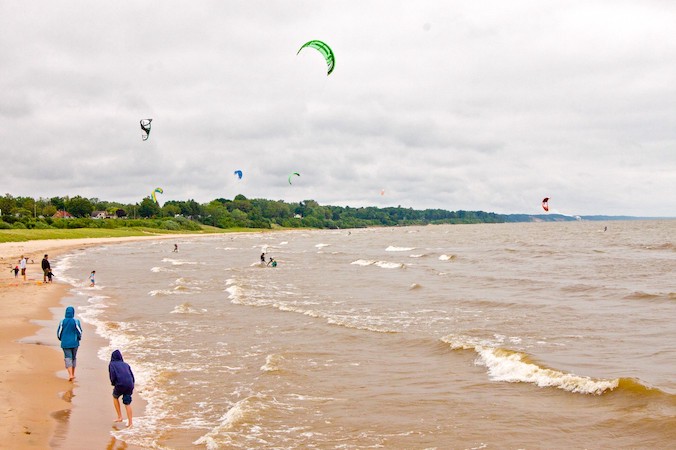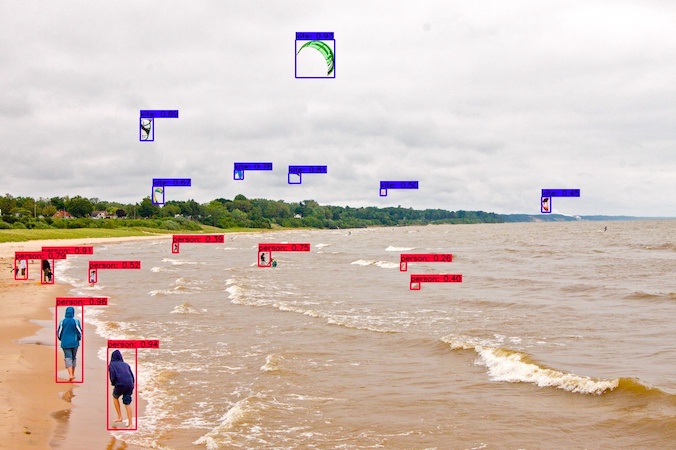This project provides a simple Flask API which offers object annotation on images with the YOLOv4 API leveraging onnxruntime. A Docker file is also provided to build an image of this API.
- Python 3.7 installed or Docker
- Download the YOLOv4 ONNX file here and add it to the
resourcesdirectory
Create a Python 3.7 environment and install the API requirements. Move to the src directory and start the API with:
python api.pyAlternatively you can build the docker image:
docker build -t sample-vision-api .Start the image and forward the port 8080.
docker run --rm -p 8080:8080 sample-vision-api:latestTo use the API:
curl -X POST "http://localhost:8080" -F "file=@kite.jpeg" --output anotated_kite.jpegAI Training allows you to deploy Docker images on a managed infrastructure tailored for AI needs, learn more about AI Training.
To deploy your API on AI Training with the CLI you first need to build the Docker image.
Once the image is built you need to push it on a remote repository, you can either create a free account on DockerHub or use a registry directly provided with AI Training.
Let's use the provided registry, from this step forward it is assumed you are logged in with the CLI (ovhai login).
First get the registry URL:
> ovhai registry list
ID TYPE URL
SHARED registry.gra.training.ai.cloud.ovh.net/<some-id>Then login to the registry:
docker login registry.gra.training.ai.cloud.ovh.net/<some-id>You will be prompted for credentials, use the same you used to login with the CLI.
Once logged in you need to retag the image we built locally and then push it:
docker tag sample-img-api:latest registry.gra.training.ai.cloud.ovh.net/<some-id>/sample-img-api:latest
docker push registry.gra.training.ai.cloud.ovh.net/<some-id>/sample-img-api:latestFinally, just run the image:
ovhai job run --cpu 4 registry.gra.training.ai.cloud.ovh.net/<some-id>/sample-img-api:latestYou can list your jobs with ovhai job list. Wait for the job we just submitted to be running. Once running a URL is provided to you to access the API:
> ovhai job list
ID STATE AGE IMAGE JOB_URL
<job-id> RUNNING 3s registry.gra.training.ai.cloud.ovh.net/<some-id>/sample-img-api https://<job-id>.job.gra.training.ai.cloud.ovh.netBy default the access to the JOB_URL is restricted and you can access with an application token. Create an application token:
> ovhai token create --role read mytoken (img-api)
---
appToken: <app-token>
token:
id: <some-id>
createdAt: "2021-04-22T15:53:49.993112679Z"
updatedAt: "2021-04-22T15:53:49.993112679Z"
name: mytoken
labelSelector: ""
version: 1The token we juste created is unscoped and valid for any job. To know more about application token and how to scope them refer to the documentation.
With the new token you can now call the vision API
export APP_TOKEN=<app-token>
curl -X POST "https://<job-id>.job.gra.training.ai.cloud.ovh.net" -F "file=@kite.jpeg" --output anotated_kite.jpeg -H "Authorization: Bearer $APP_TOKEN"Input: kite.jpeg
Output: anotated_kite.jpeg
There is two main files in the project:
api.pya basic Flask API that reads an image file from the request and return an inferred image as a resultinference.pythe inference code including preprocessing and postprocessing steps
To add your own vision API you simply need to redefine the infer function in inference.py.
This function takes an image input stream that needs to be decoded, and the ONNX runtime session with the trained model loaded.
To create additional routes refer to the Flask documentation
- YOLOv4: Optimal Speed and Accuracy of Object Detection. Alexey Bochkovskiy, Chien-Yao Wang, Hong-Yuan Mark Liao.
- Original models from Darknet Github repository.
The onnx model along with the inference code is directly extracted from ONNX models vision YOLOv4
MIT License

